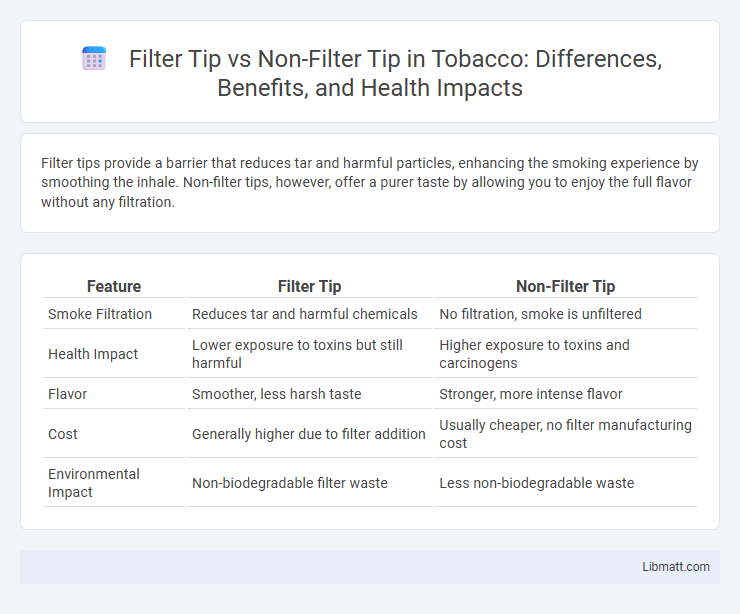Filter tips provide a barrier that reduces tar and harmful particles, enhancing the smoking experience by smoothing the inhale. Non-filter tips, however, offer a purer taste by allowing you to enjoy the full flavor without any filtration.
Table of Comparison
| Feature | Filter Tip | Non-Filter Tip |
|---|---|---|
| Smoke Filtration | Reduces tar and harmful chemicals | No filtration, smoke is unfiltered |
| Health Impact | Lower exposure to toxins but still harmful | Higher exposure to toxins and carcinogens |
| Flavor | Smoother, less harsh taste | Stronger, more intense flavor |
| Cost | Generally higher due to filter addition | Usually cheaper, no filter manufacturing cost |
| Environmental Impact | Non-biodegradable filter waste | Less non-biodegradable waste |
Introduction to Cigarette Tips
Filter tips are designed to reduce the intake of tar, nicotine, and other harmful substances by trapping some particles before they reach Your lungs, making them a popular choice among smokers seeking a smoother experience. Non-filter tips, commonly found in traditional or unfiltered cigarettes, provide a stronger, more intense flavor but expose smokers to higher levels of toxins and irritants. Understanding the differences in filtration efficiency and the impact on health can help You make an informed decision about which cigarette tip suits Your preferences and risk tolerance.
What Are Filter Tips?
Filter tips are small, removable attachments designed to fit on the end of a cigarette or rolled cigarette, serving to trap tar, smoke, and other harmful particles before inhalation. These tips improve the smoking experience by cooling smoke and reducing harshness, ultimately offering a smoother draw. Your choice between filter and non-filter tips impacts the amount of toxins inhaled and the overall flavor profile of your smoke.
What Are Non-Filter Tips?
Non-filter tips are cigarette mouthpieces made from unfiltered material, often paper or thin cardboard, allowing unfiltered smoke to pass directly through. They provide a more intense and stronger tobacco flavor experience compared to filter tips, which contain a filtering material designed to reduce tar and nicotine intake. Non-filter tips deliver higher levels of harmful substances but are preferred by some smokers seeking a traditional or unaltered taste.
Historical Evolution of Cigarette Tips
Filter tips were introduced in the 1950s as a health-conscious innovation to reduce tar and nicotine inhalation, transforming the cigarette industry by offering smokers a seemingly safer alternative. Prior to this, non-filter tips dominated the market, featuring simple paper-wrapped tobacco ends that allowed direct exposure to smoke and harmful substances. The shift from non-filter to filter tips marked a significant technological advancement aimed at minimizing health risks and influencing smoking habits globally.
Health Impacts: Filter vs Non-Filter
Filter tips in cigarettes reduce the inhalation of tar, nicotine, and other harmful chemicals, potentially lowering the risk of respiratory diseases and cancer compared to non-filter tips. Non-filter cigarettes deliver higher concentrations of toxic substances directly to the lungs, increasing the likelihood of chronic obstructive pulmonary disease (COPD), lung cancer, and cardiovascular issues. Studies consistently show a greater health burden and mortality rate among smokers using non-filter cigarettes due to increased toxic exposure.
Taste Difference: Filtered vs Unfiltered
Filtered cigarette tips significantly reduce the harshness and intensity of tobacco flavor by trapping tar and some nicotine, resulting in a smoother, milder taste preferred by many smokers. Unfiltered tips deliver a stronger, richer, and more robust tobacco flavor, as all smoke components pass directly to the mouth, offering a more authentic and intense smoking experience. The taste difference between filtered and unfiltered cigarettes primarily hinges on the filtration material's ability to alter smoke composition and temperature before inhalation.
Popularity and Consumer Trends
Filter tips dominate the cigarette market, favored by over 90% of smokers worldwide due to perceived health benefits and smoother smoking experience. Non-filter tips have seen a niche resurgence among consumers seeking a traditional, stronger flavor and a more natural smoking ritual. Recent trends indicate a gradual increase in preference for non-filter cigarettes among younger adults valuing authenticity and reduced chemical exposure.
Environmental Implications
Filter tips in cigarettes primarily consist of cellulose acetate, a plastic material that is non-biodegradable and contributes significantly to environmental pollution through littering. Non-filter tips, often made from pure tobacco rolled in paper, decompose more rapidly and produce less lasting environmental waste. Despite this, both types contribute to cigarette butt pollution, but filter tips pose a more persistent threat to ecosystems due to their slow degradation and chemical leaching.
Cost Comparison
Filter tip cigarettes typically cost more than non-filter tip cigarettes due to the added manufacturing process and materials, such as cellulose acetate filters. Non-filter tip cigarettes generally have a lower price point but lack the perceived health benefits associated with filters, influencing consumer purchasing decisions. Retail pricing data consistently shows a price variance of approximately 10-20% higher for filter tip options compared to their non-filter counterparts.
Conclusion: Which is Better?
Filter tip cigarettes reduce tar and nicotine intake by trapping harmful particles, offering a safer smoking experience compared to non-filter tips. Non-filter tip cigarettes provide a stronger, more intense flavor but increase exposure to toxins and health risks. For smokers prioritizing reduced harm, filter tips are considered the better choice despite some flavor compromise.
Filter tip vs Non-filter tip Infographic

 libmatt.com
libmatt.com